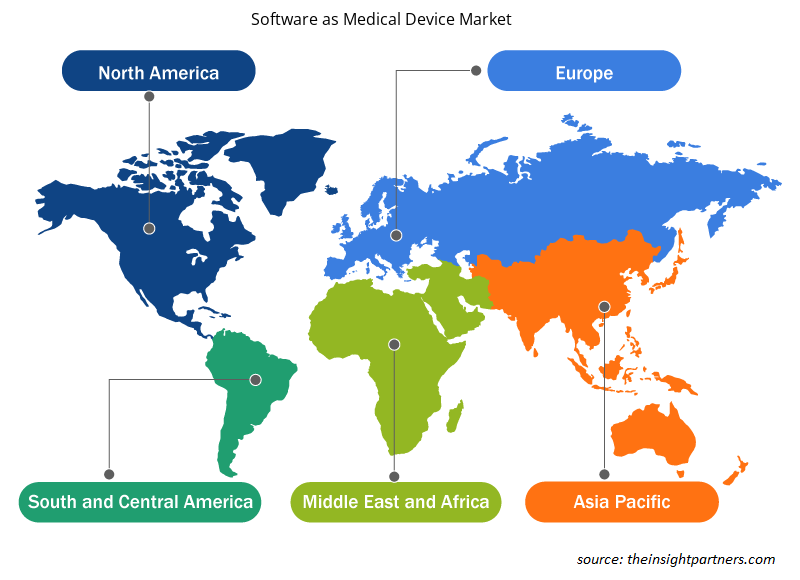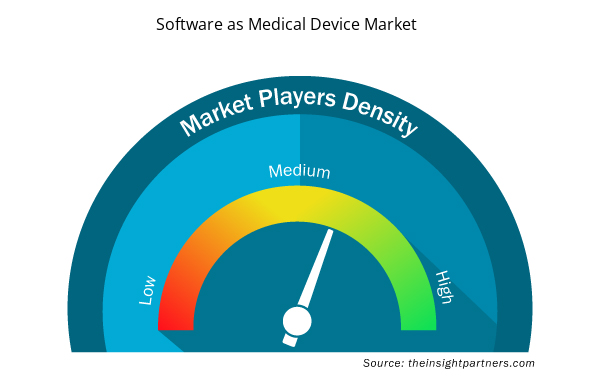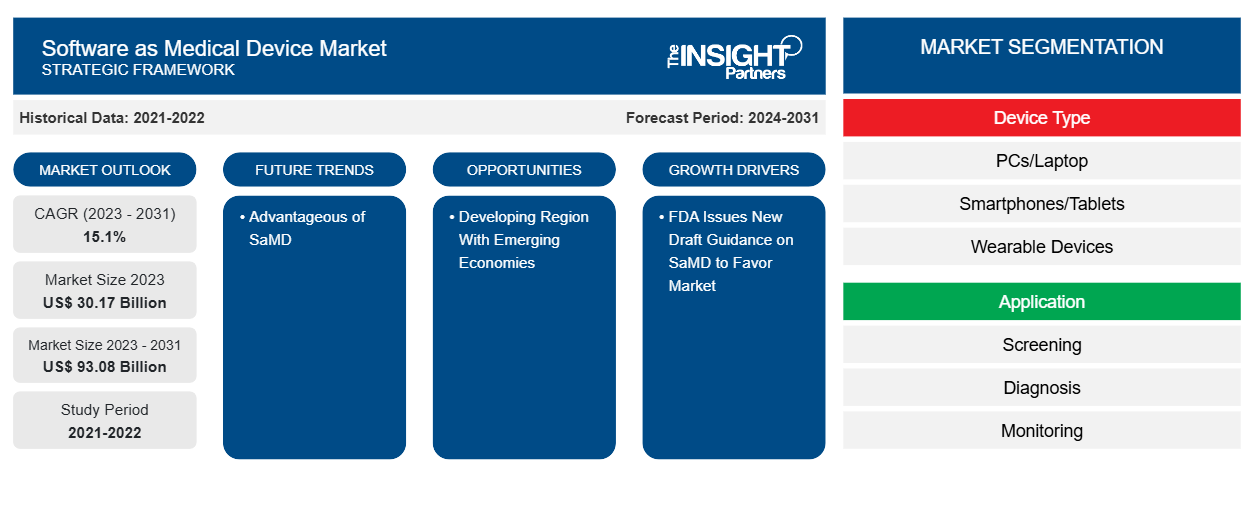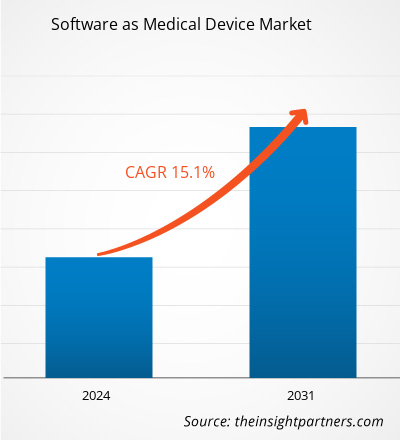Der Markt für Software als Medizinprodukt soll von 30,17 Milliarden US-Dollar im Jahr 2023 auf 93,08 Milliarden US-Dollar im Jahr 2031 anwachsen. Der Markt wird zwischen 2023 und 2031 voraussichtlich eine durchschnittliche jährliche Wachstumsrate von 15,1 % verzeichnen. Die zunehmende Anzahl tragbarer Medizinprodukte dürfte ein wichtiger Trend auf dem Markt bleiben.
Marktanalyse für Software als Medizinprodukt
In den letzten Jahren hat sich Software als Medizinprodukt (SaMD) zu einem wichtigen Instrument im Gesundheitswesen entwickelt, und ihr Wachstum dürfte sich im Jahr 2023 beschleunigen. Faktoren wie SaMD und andere digitale Lösungen verändern die Interaktion zwischen Patient und Arzt und offenbaren die Macht der gemeinsamen Nutzung, Sammlung und Nachverfolgung von Daten. Andere Faktoren wie die zunehmende Verbreitung von Virtual First Care oder V1C stehen im Vordergrund und ermöglichen es Gesundheitsdienstleistern, Pflege zu leisten, ohne einen physischen Kontakt zu riskieren. Dadurch werden Krankheiten, die aus der Ferne übertragen werden, beherrschbar.
Marktübersicht zu Software als Medizinprodukt
Mexiko konzentriert sich darauf, die Digitalisierung des Gesundheitswesens voranzutreiben, indem es die Integration softwarebasierter digitaler Lösungen in seine Infrastruktur fördert. Das Land wächst mit beispielloser Geschwindigkeit. In den letzten Jahrzehnten hat die mexikanische Regierung eine ehrgeizige Initiative gestartet, um die allgemeine Qualität der Gesundheitsversorgung durch die Implementierung digitaler Tools in ihren Gesundheitseinrichtungen zu verbessern. Die Entwicklung der digitalen Gesundheitsversorgung im Land wird wahrscheinlich auch das Wachstum des Marktes fördern und in den kommenden Jahren ein förderliches Szenario bieten. Darüber hinaus wird der Anteil der geriatrischen Bevölkerung Mexikos ab 60 Jahren von 6,3 % im Jahr 2010 auf 23 % im Jahr 2050 steigen. Daher wird erwartet, dass Faktoren wie die steigende geriatrische Bevölkerung die Nachfrage im kommenden Jahrzehnt erhöhen werden.
Passen Sie diesen Bericht Ihren Anforderungen an
Sie erhalten kostenlos individuelle Anpassungen an jedem Bericht, einschließlich Teilen dieses Berichts oder einer Analyse auf Länderebene, eines Excel-Datenpakets sowie tolle Angebote und Rabatte für Start-ups und Universitäten.
- Holen Sie sich die wichtigsten Markttrends aus diesem Bericht.Dieses KOSTENLOSE Beispiel umfasst eine Datenanalyse von Markttrends bis hin zu Schätzungen und Prognosen.
Software als Treiber und Chancen auf dem Markt für medizinische Geräte
FDA veröffentlicht neuen Leitlinienentwurf zu SaMD zur Marktförderung
Ein kürzlich veröffentlichter aktualisierter Leitfadenentwurf klärt und rationalisiert den Prozess. Dem neuen Leitfaden zufolge wurde die Software als Medizinprodukt sowohl für Patienten als auch für Pflegepersonal in Clinical Decision Support Software (CDSS) und Patient Decision Support Software (PDS) eingeteilt. Diese Klassifizierungsregeln berücksichtigen mehrere Faktoren, darunter den Grad der Invasivität im Körper, die Dauer des Kontakts, das betroffene Körpersystem und lokale versus systemische Auswirkungen. Der aktualisierte Leitfadenentwurf ist auch ein Hinweis auf eine verstärkte Entwicklung von SaMD.
Entwicklungsregionen mit Schwellenländern
Mit dem Wachstum der Wirtschaft und des Pro-Kopf-Einkommens der Menschen in den Schwellenländern steigt auch das Wachstum für verbesserte medizinische Dienstleistungen. Das Wachstum der medizinischen Industrie ist auf die zunehmende Automatisierung der Gesundheitsdienstleistungen zurückzuführen . Die globalen Marktteilnehmer ziehen die Region für ihre Geschäftsexpansion in den Schwellenländern in Betracht, was im Prognosezeitraum voraussichtlich zu einem weiteren Wachstum des Marktes für Software als Medizinprodukt (SaMD) führen wird. Nach Schätzungen der Communications and Information Technology Commission (CITC) des Königreichs nutzen die meisten (54 %) saudischen Verbraucher Technologie, um ihre Gesundheit zu verwalten, 40 % verwenden Gesundheits-Apps auf Mobilgeräten und die restlichen 14 % verwenden tragbare Technologie.
Marktsegmentierungsanalyse für Software als Medizinprodukt
Wichtige Segmente, die zur Ableitung der Marktanalyse für Software als medizinisches Gerät beigetragen haben, sind Gerätetyp, Anwendung und Bereitstellungstyp.
- Basierend auf dem Gerätetyp ist der Markt für Software als medizinisches Gerät in PCs/Laptops, Smartphones/Tablets und tragbare Geräte unterteilt. Das PCs/Laptop-Segment hatte im Jahr 2023 einen größeren Marktanteil.
- Nach Anwendung ist der Markt in Screening und Diagnose, Überwachung und Alarmierung sowie Krankheitsmanagement unterteilt. Das Segment Screening und Diagnostik hatte im Jahr 2023 den größten Marktanteil.
- In Bezug auf die Bereitstellungsart ist der Markt in Cloud und On-Premises unterteilt. Das Cloud-Segment hatte im Jahr 2023 den größten Marktanteil.
Software als Medizinprodukt – Marktanteilsanalyse nach geografischer Lage
Der geografische Umfang des Marktberichts „Software als medizinisches Gerät“ ist hauptsächlich in fünf Regionen unterteilt: Nordamerika, Asien-Pazifik, Europa, Naher Osten und Afrika sowie Süd- und Mittelamerika.
Nordamerika dominiert den Markt. Die Verbreitung von künstlicher Intelligenz, maschinellem Lernen, natürlicher Sprachverarbeitung (NLP) und deren Anwendung in der digitalen Gesundheitsfürsorge dürfte für die Dominanz des Marktes verantwortlich sein. Darüber hinaus sorgen die neuen Lösungen für die Diagnose und Fernüberwachung von Patienten durch Smartphone- und Laptop-basierte Softwarelösungen von wichtigen Marktführern für eine steigende Nachfrage nach diesen Lösungen, da sie einfach zu bedienen, zu verstehen und Gesundheitszustände zu analysieren sind und somit ihre Nachfrage steigern. Der asiatisch-pazifische Raum wird in den kommenden Jahren voraussichtlich die höchste durchschnittliche jährliche Wachstumsrate aufweisen.
Regionale Einblicke in den Markt für Software als Medizinprodukt
Die regionalen Trends und Faktoren, die den Markt für Software als Medizinprodukt im Prognosezeitraum beeinflussen, wurden von den Analysten von Insight Partners ausführlich erläutert. In diesem Abschnitt werden auch Marktsegmente und Geografien für Software als Medizinprodukt in Nordamerika, Europa, im asiatisch-pazifischen Raum, im Nahen Osten und Afrika sowie in Süd- und Mittelamerika erörtert.

- Erhalten Sie regionale Daten zum Markt für Software als Medizinprodukt
Umfang des Marktberichts über Software als Medizinprodukt
| Berichtsattribut | Details |
|---|---|
| Marktgröße im Jahr 2023 | 30,17 Milliarden US-Dollar |
| Marktgröße bis 2031 | 93,08 Milliarden US-Dollar |
| Globale CAGR (2023 - 2031) | 15,1 % |
| Historische Daten | 2021-2022 |
| Prognosezeitraum | 2024–2031 |
| Abgedeckte Segmente | Nach Gerätetyp
|
| Abgedeckte Regionen und Länder | Nordamerika
|
| Marktführer und wichtige Unternehmensprofile |
|
Marktteilnehmerdichte: Der Einfluss auf die Geschäftsdynamik
Der Markt für Software als Medizinprodukt wächst rasant. Dies wird durch die steigende Nachfrage der Endnutzer aufgrund von Faktoren wie sich entwickelnden Verbraucherpräferenzen, technologischen Fortschritten und einem größeren Bewusstsein für die Vorteile des Produkts vorangetrieben. Mit der steigenden Nachfrage erweitern Unternehmen ihr Angebot, entwickeln Innovationen, um die Bedürfnisse der Verbraucher zu erfüllen, und nutzen neue Trends, was das Marktwachstum weiter ankurbelt.
Die Marktteilnehmerdichte bezieht sich auf die Verteilung der Firmen oder Unternehmen, die in einem bestimmten Markt oder einer bestimmten Branche tätig sind. Sie gibt an, wie viele Wettbewerber (Marktteilnehmer) in einem bestimmten Marktraum im Verhältnis zu seiner Größe oder seinem gesamten Marktwert präsent sind.
Die wichtigsten Unternehmen auf dem Markt für Software als Medizinprodukt sind:
- Velentium LLC
- Tietronix Software, Inc.
- S3 Vernetzte Gesundheit
- Zühlke Gruppe
- Wissenschaftsgruppe
- Inzentiz
Haftungsausschluss : Die oben aufgeführten Unternehmen sind nicht in einer bestimmten Reihenfolge aufgeführt.

- Überblick über die wichtigsten Akteure auf dem Markt für Software als medizinisches Gerät
Neuigkeiten und aktuelle Entwicklungen zum Markt für Software als Medizinprodukt
Der Markt für Software als Medizinprodukt wird durch die Erhebung qualitativer und quantitativer Daten nach Primär- und Sekundärforschung bewertet, die wichtige Unternehmensveröffentlichungen, Verbandsdaten und Datenbanken umfasst. Nachfolgend sind einige der Entwicklungen auf dem Markt für Software als Medizinprodukt aufgeführt:
- CompliancePath und Ideagen sind eine Produktvalidierungspartnerschaft eingegangen, um ihr laufendes Validierungsbeschleunigungsprogramm auf alle Life-Science-bezogenen Softwareprodukte auszuweiten. (Quelle: CompliancePath, Pressemitteilung, April 2020)
- Das in den USA ansässige Unternehmen STAT Health hat ein rund um die Uhr tragbares Im-Ohr-Produkt für das allgemeine Wohlbefinden vorgestellt, das den Blutfluss misst. (Quelle: STAT Health, Pressemitteilung, Juni 2023)
Marktbericht zu Software als Medizinprodukt – Umfang und Ergebnisse
Der Bericht „Marktgröße und Prognose für Software als Medizinprodukt (2021–2031)“ bietet eine detaillierte Analyse des Marktes, die die folgenden Bereiche abdeckt:
- Marktgröße und Prognose für Software als Medizinprodukt auf globaler, regionaler und Länderebene für alle wichtigen Marktsegmente, die im Rahmen des Berichts abgedeckt sind
- Markttrends und Marktdynamiken für Software als Medizinprodukt, darunter Treiber, Einschränkungen und wichtige Chancen
- Detaillierte PEST/Porters Five Forces- und SWOT-Analyse
- Marktanalyse für Software als Medizinprodukt, die wichtige Markttrends, globale und regionale Rahmenbedingungen, wichtige Akteure, Vorschriften und aktuelle Marktentwicklungen umfasst
- Branchenlandschaft und Wettbewerbsanalyse, die die Marktkonzentration, Heatmap-Analyse, prominente Akteure und aktuelle Entwicklungen für den Markt für Software als Medizinprodukt umfasst
- Detaillierte Firmenprofile
- Historische Analyse (2 Jahre), Basisjahr, Prognose (7 Jahre) mit CAGR
- PEST- und SWOT-Analyse
- Marktgröße Wert/Volumen – Global, Regional, Land
- Branche und Wettbewerbsumfeld
- Excel-Datensatz


- Quantitative Structure-Activity Relationship (QSAR) Market
- Travel Vaccines Market
- Europe Industrial Chillers Market
- Pharmacovigilance and Drug Safety Software Market
- Thermal Energy Storage Market
- Small Satellite Market
- Workwear Market
- Malaria Treatment Market
- Vision Guided Robotics Software Market
- Microplate Reader Market

Report Coverage
Revenue forecast, Company Analysis, Industry landscape, Growth factors, and Trends

Segment Covered
This text is related
to segments covered.

Regional Scope
North America, Europe, Asia Pacific, Middle East & Africa, South & Central America

Country Scope
This text is related
to country scope.
Häufig gestellte Fragen
North America held the largest market for Software as Medical Device. The growth of the region is attributed to continuous rise in the use of Software as Medical Device, innovations in software designs, and increasing awareness among people regarding the benefits for digital healthcare applications.
The driving factors are increasing adoption of Internet of Things (IoT) & connected devices in healthcare and the advantages offered by Software as Medical Device (SaMD).
Increasing number of wearable medical devices is likely to remain key trends in the market.
S3 Connected Health, BrightInsight, Inc. and CompliancePath are among the top players operating in the Software as Medical Device market.
The software as medical device market size is projected to reach US$ 93.08 billion by 2031.
The market is expected to register a CAGR of 15.1% during 2023–2031.
Trends and growth analysis reports related to Technology, Media and Telecommunications : READ MORE..
The Insight Partners performs research in 4 major stages: Data Collection & Secondary Research, Primary Research, Data Analysis and Data Triangulation & Final Review.
- Data Collection and Secondary Research:
As a market research and consulting firm operating from a decade, we have published and advised several client across the globe. First step for any study will start with an assessment of currently available data and insights from existing reports. Further, historical and current market information is collected from Investor Presentations, Annual Reports, SEC Filings, etc., and other information related to company’s performance and market positioning are gathered from Paid Databases (Factiva, Hoovers, and Reuters) and various other publications available in public domain.
Several associations trade associates, technical forums, institutes, societies and organization are accessed to gain technical as well as market related insights through their publications such as research papers, blogs and press releases related to the studies are referred to get cues about the market. Further, white papers, journals, magazines, and other news articles published in last 3 years are scrutinized and analyzed to understand the current market trends.
- Primary Research:
The primarily interview analysis comprise of data obtained from industry participants interview and answers to survey questions gathered by in-house primary team.
For primary research, interviews are conducted with industry experts/CEOs/Marketing Managers/VPs/Subject Matter Experts from both demand and supply side to get a 360-degree view of the market. The primary team conducts several interviews based on the complexity of the markets to understand the various market trends and dynamics which makes research more credible and precise.
A typical research interview fulfils the following functions:
- Provides first-hand information on the market size, market trends, growth trends, competitive landscape, and outlook
- Validates and strengthens in-house secondary research findings
- Develops the analysis team’s expertise and market understanding
Primary research involves email interactions and telephone interviews for each market, category, segment, and sub-segment across geographies. The participants who typically take part in such a process include, but are not limited to:
- Industry participants: VPs, business development managers, market intelligence managers and national sales managers
- Outside experts: Valuation experts, research analysts and key opinion leaders specializing in the electronics and semiconductor industry.
Below is the breakup of our primary respondents by company, designation, and region:

Once we receive the confirmation from primary research sources or primary respondents, we finalize the base year market estimation and forecast the data as per the macroeconomic and microeconomic factors assessed during data collection.
- Data Analysis:
Once data is validated through both secondary as well as primary respondents, we finalize the market estimations by hypothesis formulation and factor analysis at regional and country level.
- Macro-Economic Factor Analysis:
We analyse macroeconomic indicators such the gross domestic product (GDP), increase in the demand for goods and services across industries, technological advancement, regional economic growth, governmental policies, the influence of COVID-19, PEST analysis, and other aspects. This analysis aids in setting benchmarks for various nations/regions and approximating market splits. Additionally, the general trend of the aforementioned components aid in determining the market's development possibilities.
- Country Level Data:
Various factors that are especially aligned to the country are taken into account to determine the market size for a certain area and country, including the presence of vendors, such as headquarters and offices, the country's GDP, demand patterns, and industry growth. To comprehend the market dynamics for the nation, a number of growth variables, inhibitors, application areas, and current market trends are researched. The aforementioned elements aid in determining the country's overall market's growth potential.
- Company Profile:
The “Table of Contents” is formulated by listing and analyzing more than 25 - 30 companies operating in the market ecosystem across geographies. However, we profile only 10 companies as a standard practice in our syndicate reports. These 10 companies comprise leading, emerging, and regional players. Nonetheless, our analysis is not restricted to the 10 listed companies, we also analyze other companies present in the market to develop a holistic view and understand the prevailing trends. The “Company Profiles” section in the report covers key facts, business description, products & services, financial information, SWOT analysis, and key developments. The financial information presented is extracted from the annual reports and official documents of the publicly listed companies. Upon collecting the information for the sections of respective companies, we verify them via various primary sources and then compile the data in respective company profiles. The company level information helps us in deriving the base number as well as in forecasting the market size.
- Developing Base Number:
Aggregation of sales statistics (2020-2022) and macro-economic factor, and other secondary and primary research insights are utilized to arrive at base number and related market shares for 2022. The data gaps are identified in this step and relevant market data is analyzed, collected from paid primary interviews or databases. On finalizing the base year market size, forecasts are developed on the basis of macro-economic, industry and market growth factors and company level analysis.
- Data Triangulation and Final Review:
The market findings and base year market size calculations are validated from supply as well as demand side. Demand side validations are based on macro-economic factor analysis and benchmarks for respective regions and countries. In case of supply side validations, revenues of major companies are estimated (in case not available) based on industry benchmark, approximate number of employees, product portfolio, and primary interviews revenues are gathered. Further revenue from target product/service segment is assessed to avoid overshooting of market statistics. In case of heavy deviations between supply and demand side values, all thes steps are repeated to achieve synchronization.
We follow an iterative model, wherein we share our research findings with Subject Matter Experts (SME’s) and Key Opinion Leaders (KOLs) until consensus view of the market is not formulated – this model negates any drastic deviation in the opinions of experts. Only validated and universally acceptable research findings are quoted in our reports.
We have important check points that we use to validate our research findings – which we call – data triangulation, where we validate the information, we generate from secondary sources with primary interviews and then we re-validate with our internal data bases and Subject matter experts. This comprehensive model enables us to deliver high quality, reliable data in shortest possible time.


 Holen Sie sich ein kostenloses Muster für diesen Bericht
Holen Sie sich ein kostenloses Muster für diesen Bericht